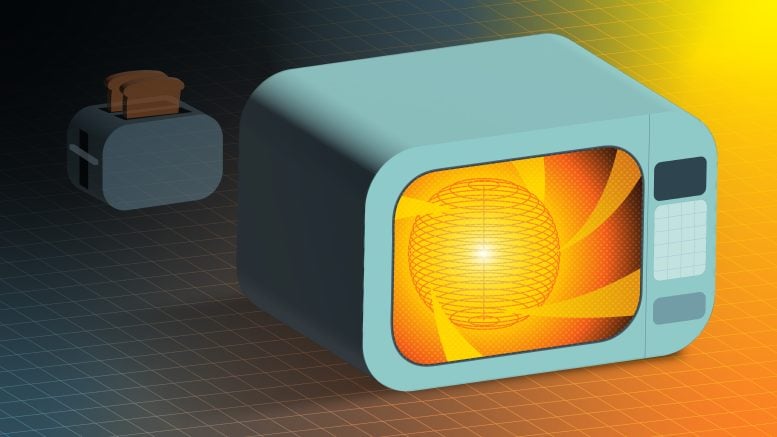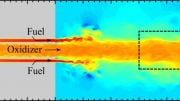
An artist’s metaphoric depiction of a fusion plasma in a microwave, with a toaster in the background. Credit: Kyle Palmer / PPPL Communications Department
Carving a new path forward for compact fusion vessels.
Some experts believe that the future of fusion in the U.S. may be found in compact, spherical fusion vessels. A smaller tokamak is seen as a potentially more economical solution for fusion energy. The challenge lies in fitting all necessary components into a limited space. Recent research indicates that removing one key component used to heat the plasma could create the additional space required.
Scientists at the U.S. Department of Energy’s (DOE) Princeton Plasma Physics Laboratory (PPPL), the private company Tokamak Energy, and Kyushu University in Japan have proposed a design for a compact, spherical fusion pilot plant that heats the plasma using only microwaves. Typically, spherical tokamaks also use a massive coil of copper wire called a solenoid, located near the center of the vessel, to heat the plasma. Neutral beam injection, which involves applying beams of uncharged particles to the plasma, is often used as well. But much like a tiny kitchen is easier to design if it has fewer appliances, it would be simpler and more economical to make a compact tokamak if it has fewer heating systems.
The new approach eliminates ohmic heating, which is the same heating that happens in a toaster and is standard in tokamaks. “A compact, spherical tokamak plasma looks like a cored apple with a relatively small core, so one does not have the space for an ohmic heating coil,” said Masayuki Ono, a principal research physicist at PPPL and lead author of the paper detailing the new research. “If we don’t have to include an ohmic heating coil, we can probably design a machine that is easier and cheaper to build.”
Identifying the ideal beam angle and heating mode
Microwaves are a form of electromagnetic radiation that can be generated using a device known as a gyrotron. The gyrotrons would sit on the outside of the tokamak — metaphorically speaking, just outside the apple skin — aimed toward the core. As the gyrotrons emitted powerful waves into the plasma, they would generate a current by moving negatively charged particles known as electrons. This process, known as electron cyclotron current drive (ECCD), both drives a current in and heats up the plasma. The heating process is not as simple as just turning on some gyrotrons, however. The researchers need to model different scenarios and determine various details, such as the best angle to aim the gyrotrons so the microwaves penetrate the plasma properly.
Using a computer code called TORAY coupled with one called TRANSP, the team scanned the aiming angles and saw what gave the highest efficiency. The goal is to use as little power as possible to drive the necessary current. “Also, you have to try to avoid any of the power that you’re putting into the plasma coming back out,” said Jack Berkery, a co-author on the paper and the deputy director of research for the National Spherical Torus Experiment-Upgrade (NSTX-U). This can happen when the microwaves are reflected off the plasma or when they enter the plasma but exit without changing the plasma’s current or temperature. “There were a lot of scans of different parameters to find the best solution,” Berkery said.
The research team also determined which mode of ECCD would work best for each phase of the heating process. There are two modes: ordinary mode, known as O mode, and extraordinary mode, known as X mode. The researchers see X mode as the best fit for ramping up the temperature and current of the plasma, while O mode is the best choice after the ramp-up, when the plasma temperature and current simply need to be maintained.
“O mode is good for a high-temperature, high-density plasma. But we found that O mode efficiency becomes very poor at lower temperatures, so you need something else to take care of the low-temperature regime,” said Ono.
Considering the impact of impurities
The authors, including postdoctoral researcher Kajal Shah, also investigated how power would radiate away from the plasma. Such radiation could be significant in a plasma as big as one needed for commercial fusion. Luis Delgado-Aparicio, the Lab’s head of the Advanced Projects Department and a co-author on the paper, notes that it will be particularly important to minimize the number of impurities from elements with a high atomic number, which is also known as a Z number, in the periodic table. Those are the elements with many positively charged particles, known as protons. The more protons an element has, the higher its Z number and the more it can contribute to heat loss. Tungsten and molybdenum, for example, have Z numbers, so their use inside a compact spherical tokamak would need to be carefully considered with an eye toward running the reactor in ways that would reduce impurity transfer into the plasma.
While the strong magnetic fields largely confine the plasma inside a tokamak in a particular shape, sometimes plasma can come close to the interior walls of the tokamak. “When this happens, atoms from the walls can sputter off and enter the plasma, cooling it,” said Delgado-Aparicio. “Even a relatively small amount of an element with a high Z number can cause the temperature of the plasma to cool significantly.” So, it is particularly important to keep impurities out of the plasma — as much as possible — particularly while the temperature is still ramping up.
Private-public partnerships: The future of fusion
The heating simulations are part of a design project known as the Spherical Tokamak Advanced Reactor or STAR. The project is a strategic initiative to develop plans for a pilot power plant. Berkery said the project provides PPPL researchers with an opportunity to apply their expertise in physics, engineering, and working with the computer codes for fusion simulations while working in partnership with private firms on their plans for fusion power plants with a spherical tokamak design.
Vladimir Shevchenko, a co-author on the paper and a senior technical adviser at Tokamak Energy, said he plans to run experiments at the end of next year in the company’s fusion vessel, ST40, to compare to the simulation results presented in the paper. “Other heating systems have very, very serious problems,” Shevchenko said. “I see this as the future for tokamak heating systems.”
Shevchenko thinks the project benefits from the public-private partnership between PPPL and Tokamak Energy, one of the companies selected for the DOE milestone-based fusion development program. “PPPL has a lot of experienced specialists in different areas related to plasma physics and tokamak technologies. Their contribution in terms of modeling and advising is very valuable for a private company like Tokamak Energy,” he said.
Reference: “Efficient ECCD non-inductive plasma current start-up, ramp-up, and sustainment for an ST fusion reactor” by M. Ono, J.W. Berkery, N. Bertelli, S. Shiraiwa, L. Delgado-Aparicio, J.E. Menard, Á. Sánchez-Villar, K. Shah, V. Shevchenko, H. Idei and K. Hanada, 19 June 2024, Nuclear Fusion.
DOI: 10.1088/1741-4326/ad556f
Other PPPL researchers on this project include Nicola Bertelli, Syun’ichi Shiraiwa, Jon Menard and Álvaro Sánchez Villar. This research was completed with funding from the DOE under contract number DE-AC02-09CH11466.









Be the first to comment on "A Simpler Path to Fusion: The Promise of Spherical Tokamak Technology"